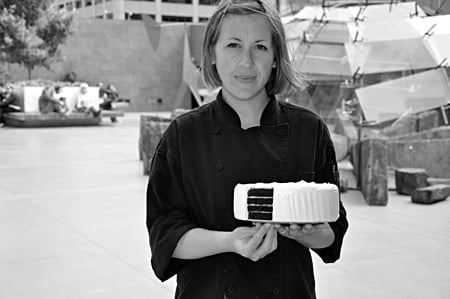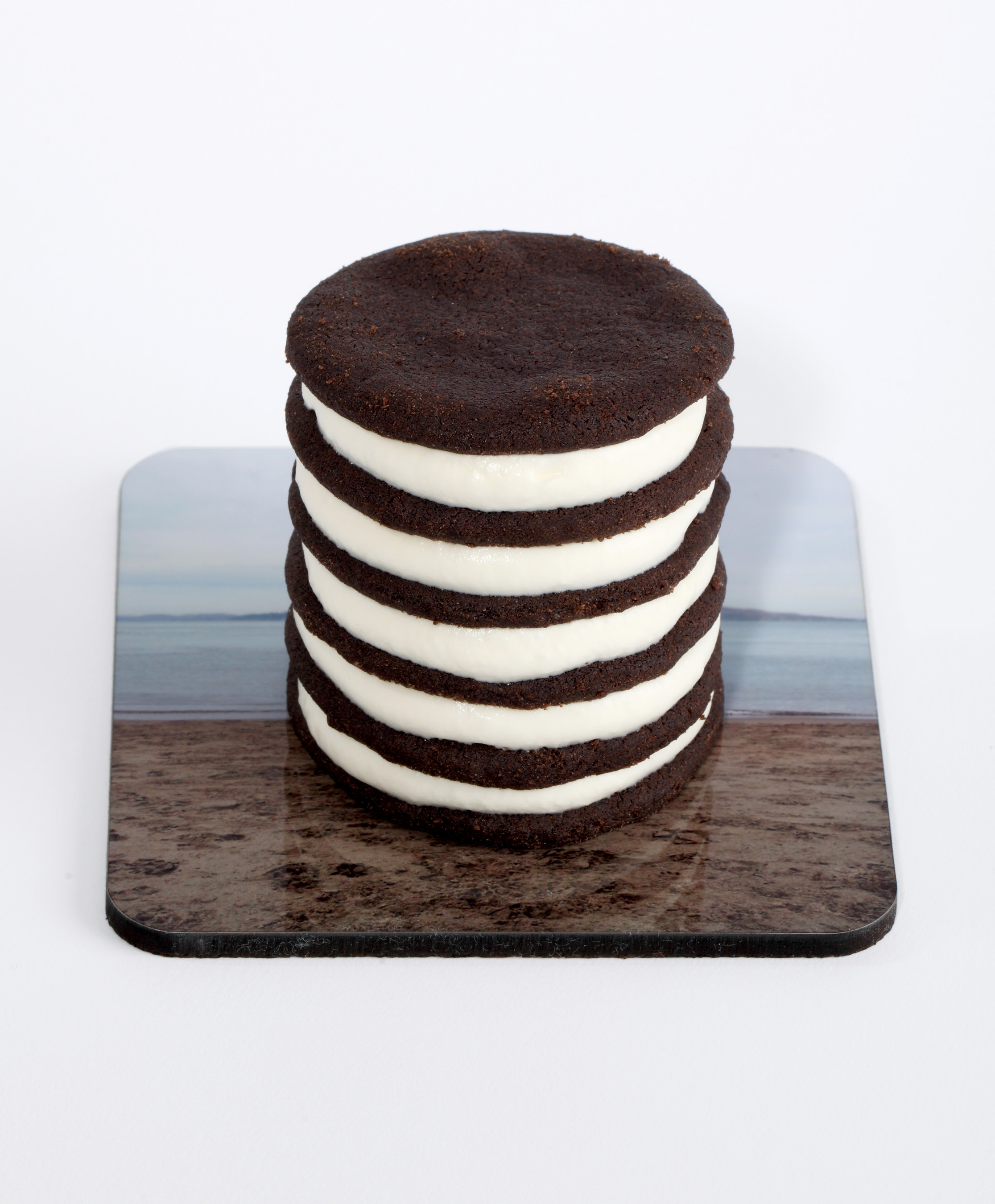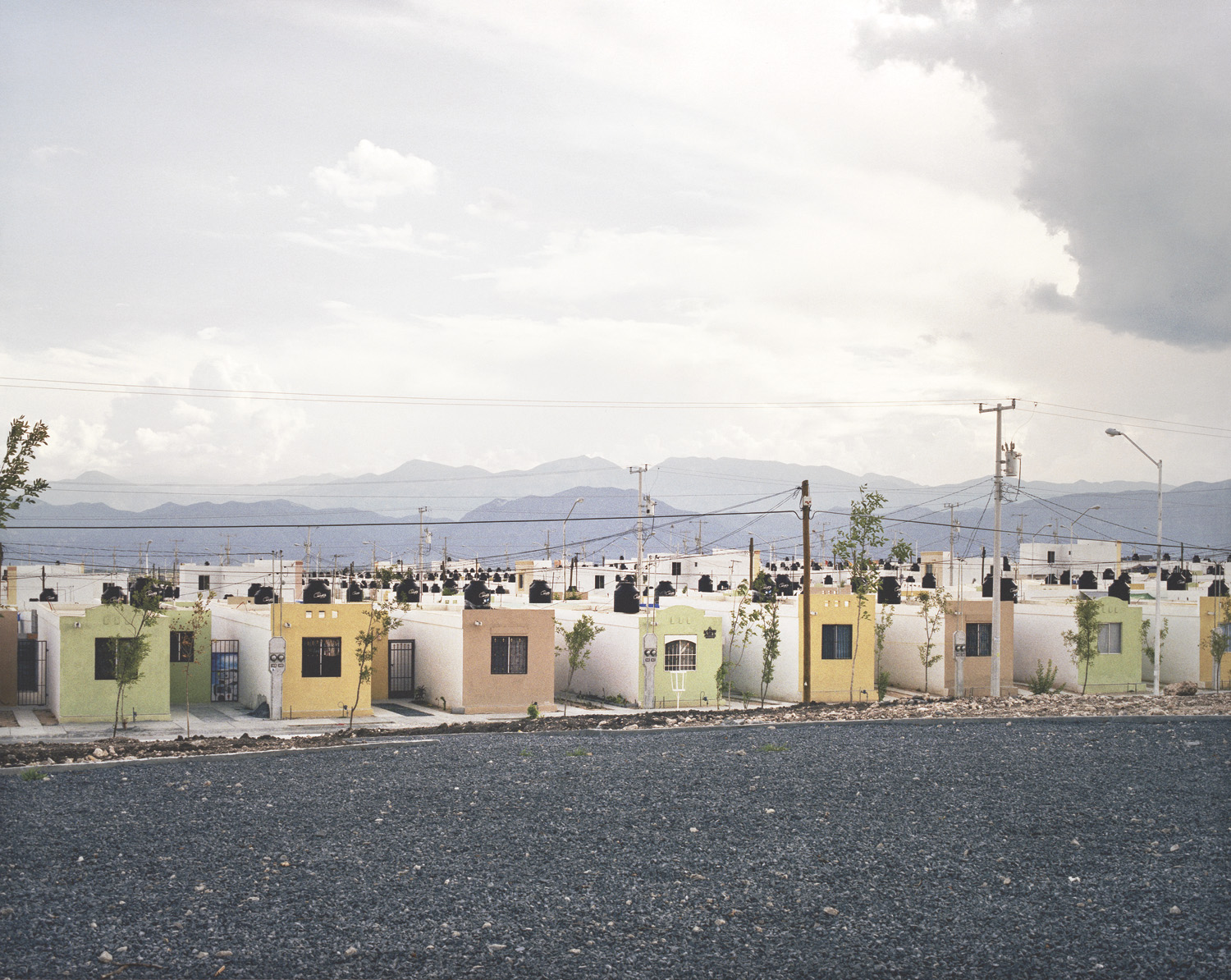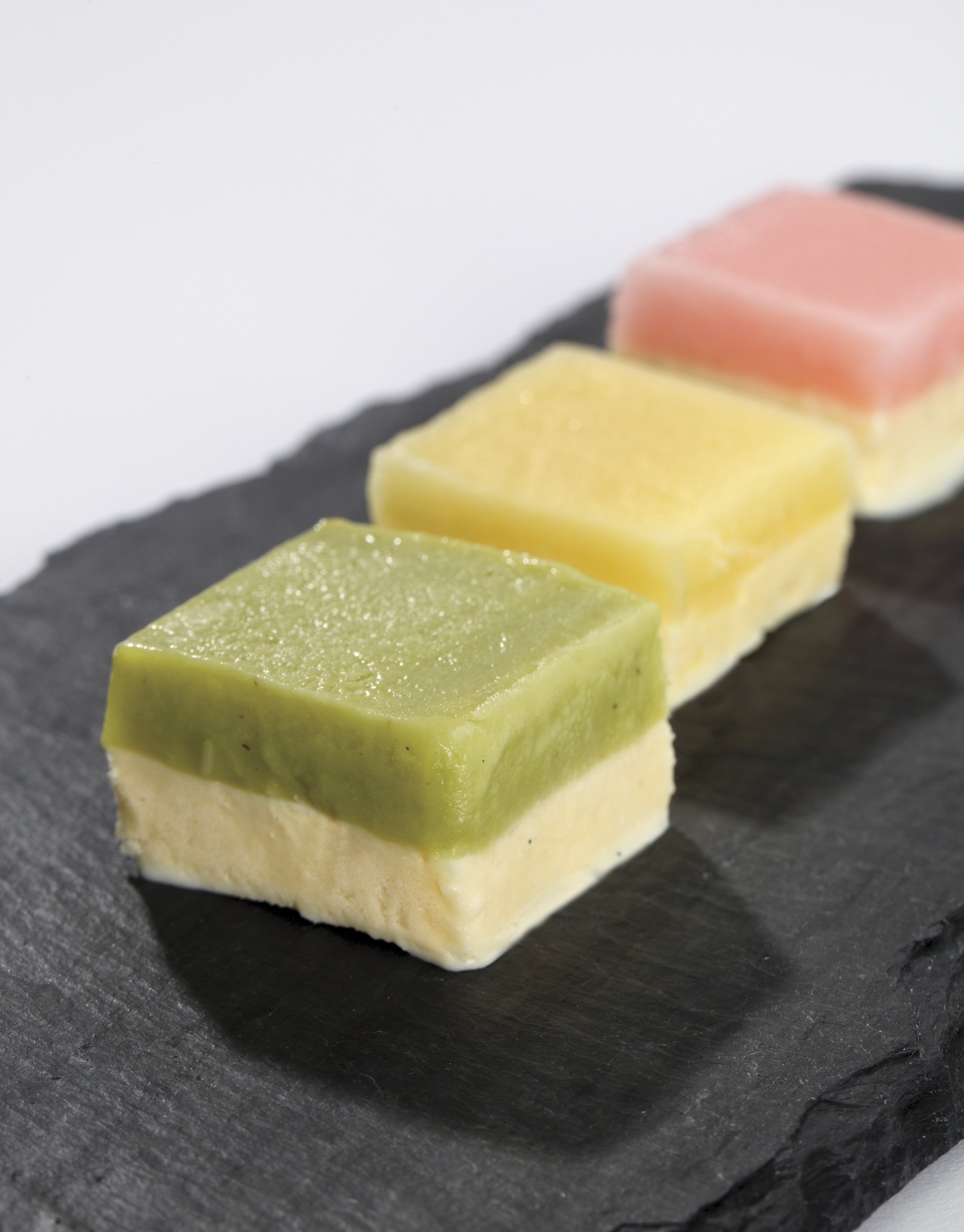Art World
Q & A with Art Pastry Chef and Author: Caitlin Freeman
An interview with Caitlin Freeman, Modern art pastry chef.

An interview with Caitlin Freeman, Modern art pastry chef.

Thierry Dumoulin


Caitlin Freeman, Clay McLachlan © 2013
Thierry Dumoulin: How did you become a pastry chef?
Caitlin Freeman: I was an art student at UC Santa Cruz in the early 1990s, and, as part of our photography course, we used to go to San Francisco to visit galleries. We used to go to The San Francisco Museum of Modern Art regularly. On one of those visits, I fell in love with a painting of cakes by Wayne Thiebaud (American, b.1920). I just loved the feeling of it: beautiful, simple cakes. They weren’t girly, like wedding cakes, but had an amazing texture that made you feel like you wanted to be a part of his world. They made you feel a bit nostalgic. The brown tones made it feel modern and clean, and that was the world I wanted to live in: a sensuous world that was almost tom-boy girly. At the time, I was working at a bakery, as a counter girl. I didn’t know what I really wanted. I was doing a lot of self-portraits and moody photography. But I wanted the feeling of Thiebaud’s painting in my life.
I graduated, and started working at tech companies in San Francisco (the dot-com boom was in full swing then). I hated it! In 2000, I went to see a retrospective of Thiebaud’s work, and that’s when I decided: this is what I want to do with my life. It took me a while to sort out what I was going to do, but I knew it was going to be around cakes. I thought I wanted to do photography exhibitions based on cakes, but I needed to learn how to make them. So I found a woman who had started a bakery, called Miette, and I worked for free for a year. It was an amazing opportunity; she didn’t really know what she was doing either, so I got to have a genuine say and have an influence on what was happening while I was learning. We became business partners, and suddenly I was a co-business owner and a baker. It was great! I devoted my entire life to it: that what I did 20 hours a day, seven days a week.
There were definitely cakes inspired by Thiebaud, but they were not replicas. I wanted them to be authentic, to come from me. At the end of 2008, I sold the business, and it was heart-breaking, because that was my whole identity at the time. I had put my heart and soul into it, and I wasn’t sure what I was going to do next. Being a business owner and a pastry chef had happened by accident, and that was not what I had originally intended to happen. I had devoted myself to what I was doing, and I was very serious about it, but I wondered if that was really what I wanted.
So I started thinking about what I should really be doing with my life, especially since being a pastry chef is a bit ludicrous. It’s so hard on your body, and you get paid next to nothing. It’s not a sustainable way to live. At that point, I was in my early thirties. My husband owns a company called Blue Bottle Coffee, and I figured I could always sort out what to do with my life later, and I could start by building a pastry shop for him, creating pastries for his coffee shops. A couple of months later, The San Francisco Museum of Modern Art called and asked if we wanted to open a coffee shop in their sculpture garden. That’s when I was taken back to 10 years before, when I first came across Thiebaud’s cakes that had started everything. This spun me off into a whole new adventure. Now, we make pastries inspired by what is on display in the museum, which is always changing. This is my dream job, which I never imagined would be possible.
We’re launching a pop-up shop at New York’s The Museum of Modern Art on May 15 through 21. My hope is that we can tie to some of the works there, but it’s different than at The San Francisco Museum of Modern Art, where we are really integrated into the fabric of the museum. Curators often come sit down with us to have coffee in our café, so we know them really well, and we are immersed in what is going on or coming up. When we started this New York Museum of Modern Art project, we wanted to talk to the curators and see the exhibition check list, and they were simply not used to this cross-over. Danny Meyer’s café is fantastic, and they are so good at what they do, making fantastic food, but with no cross-pollination.
When I wanted to reach out to curators, it was not a familiar concept for them, so my understanding of their current exhibits is limited, and I can’t wait to explore the exhibits and try to come up with ideas. Of course we will have our classics available: the Piet Mondrian cake, the Thiebaud cake, and the Andy Warhol jello (which will resonate with the big Mao in the café). We’ll start off with those, and then my team and I (there are three of us here in New York) will take turns at the kitchen and in the galleries, and come up with new ideas. Ellsworth Kelly’s 90th birthday is coming up at the end of the month, and both Museums of Modern Art are having exhibitions to celebrate his work, so I want to throw this bi-coastal birthday party. I want to start planning for that, and hopefully find a way to make it happen, and have fun with it.

Rineke Dijkstra, De Panne, Belgium, 1992, chromogenic print, Heather and Tony Podesta Collection, Washington, D.C.

De Panne, Belgium by Rineke Dijkstra was the inspiration for the chocolate sable cookies and homemade whipped cream. Clay McLachlan © 2013
TD: How long does it take you between the moment you get inspired and when a cake is available?
CF: It really depends, and a lot of it has to do with my schedule and my ability. Often we are working months in advance at The San Francisco Museum of Art, so we tend to put things off for a while. Sometimes, we sit down to a meeting and we come up with something right away, and we can develop a dessert pretty quickly. So I’m hoping that since all three of us will be doing this full-time, it will be pretty quick, and we can also fall back on our reserves. It’s pretty easy to modify something we have already done, such as the Cindy Sherman ice cream float. We can use the recipes of what we already have and push out an ice cream float fairly quickly, of course with different themes. We’re always making custom coasters or finding little cups, or the special things that push the dessert over the edge. This poses a little bit more of a challenge.
TD: In terms of your process, which comes first, is it that work of art first, or is it the artist first?
CF: A lot of what we do is responding to the traveling exhibitions at The San Francisco Museum of Modern Art. We do try as much as we can to keep things going from the permanent collection, because that is a little easier for us; we can get used to making it, and it can be on the menu for a long time. However, the excitement often comes from the traveling exhibitions, such as, most recently, the Garry Winogrand (American, 1928–1984) show. I’ll have 300 images plopped on my desk, and then I have to pick one with which to work. It’s a process: we go through and we do a quick overview of the images and see what comes up. There are often easy fallbacks, like a woman eating an ice cream cone; we know we can make an ice cream based on that. We look for shapes and colors, and so black-and-white photographs are harder, because obviously there aren’t many geometric colors to work with.
So we go through the images and find things that we think that look like a certain dessert, or look like a component of a dessert. For instance, if a figure’s hair looks like chocolate curls, we think about how we can build something out of that. We also have to think about what our customers want to eat at the café, which is a big component. As much as we like to come up with these wild ideas, we do need people to buy them. For instance, we did this cheese and crackers platter that worked really great for a Mark Bradford (American, b.1961) show. Customers seemed to really like cheese and crackers, and so perhaps we’ll try another similar dish in the future. Sometimes, we think about how we need to find something savory, and how it would be great to do a sandwich or soup. It was never my focus to do anything savory, but we have realized that people are pretty excited if we have one item that is not a cake, or an ice cream float, or hot chocolate.
TD: Do you ever get feedback from any of the artists?
CF: We do, and it’s really amazing. Often they don’t know what we are doing, and when they find out, they’re generally very delighted. I had three artists that were in the book on a panel discussion for our book launch party in San Francesco. We worked with Ruth Laskey while we were coming up with a dessert. There’s also Rosana Castro Diaz, for whom we made a panna cotta based on a big mural, and Andrew Kudless, for whom we did a s’more based on one of his big pieces. I had never met them before, and in fact Kudless didn’t know anything about the dessert until we called him to ask if we could reprint his art in the book. They were so wonderful and delighted, and so amazed that someone had done this for them.
We also got to meet Cindy Sherman, which was very exciting. She came up and had her ice cream float, and took pictures of it on her iPhone. Her main concern was how we were going to keep people from stealing the coasters and the little bottles that were a part of it. It was fun to talk to an artist about the technical aspects of building this thing, which you can tell related to her work and the technical ways that she transforms her image into something else. It was a great conversation to have with her. Not all artists are delighted, but a lot of them are.
TD: Do you ever have any legal issues, in terms of clearance for rights?
CF: No, because what we’re doing is a derivative work based on an image. I did learn a lot about the legal process, working with the Warhol Foundation and the Mondrian Trust for instance, for the book and re-printing of the original artworks. A lot of artists were really great. They’d often say something along the lines of “just send me a couple of copies of the book and go ahead and use it.” A couple of people wanted us to pay, but it was maybe US$200 or something, which is still very generous.
Any time the trusts or the foundations were involved, that’s when it really became a business transaction. In some ways, with the bigger companies that manage multiple trusts, I knew I was going to pay, but I knew I didn’t have to jump through any hoops. They wanted to know how many I was going to print and how big they were, and they wanted to make sure certain people had the right copyrights, but it was a business transaction. There were others that I felt I had to jump through hoops. There was only one person who said that I couldn’t use his image. That’s fine and I respect that; we still had plenty of beautiful things to use. The budget for my rights and reproductions more than doubled once I got into it. The San Francisco Museum of Modern Art was fantastic in helping me sort all of that out.
TD: How did the idea of the book come about?
CF: We had been doing this project for quite awhile and it made sense to do a book because it was so visual. However, I wasn’t able to think about it for a long time, because every time I started thinking about it, I’d start thinking about the rights and reproductions, and how hard that was going to be, and how possibly impossible it was going to be, and I couldn’t imagine a book without the side by side art images with the dessert images. My husband and I were working on a Blue Bottle book with Ten Speed Press, so we were already in the book-writing mode. So it occurred to me that I could figure this out, and I had a few great people spurring me on. Then my editor from the Blue Bottle book got involved, and she was really excited and supportive. So I just jumped into it. All of my pastry kitchens (I have three that I run) are self-sustaining; they didn’t need me, so I could be at home in pajamas writing books. So I thought well, I might as well continue. Also, The San Francisco Museum of Modern Art was closing, and it made sense for this book to come out just before the museum closed.

Alejandro Cartagena, Fragmented Cities, Juarez #2, from the Suburbia Mexicana series, 2007, inkjet print, San Francisco Museum of Modern Art, San Francisco, CA

Fragmented Cities, Juarez #2 by Alejandro Cartagena was the inspiration for the vanilla ice cream and sorbet trio Clay McLachlan © 2013
TD: How good of a cook do you have to be to try making your recipes?
CF: I’m not formally trained, so all of this is definitely doable. None of the recipes themselves are hard. There are things, like tempering chocolate, which are a pain in the neck, and I readily admit that they are a pain in the neck in the book, and I give you alternatives. Often the recipe that’s written isn’t necessarily what’s photographed. I have a section called “above and beyond,” so if you really want to go all these extra steps, like print custom ribbons for the Frida Kahlo (Mexican, 1907–1954), I’ll tell you how to do it, and I’ll lay out for you the resources you need, recognizing that not many people are going to do it.
There is a recipe for really easy and great Mexican wedding cookies that are delicious and easy to do. You can make it as hard as you want to (or not). All of the individual recipes are super simple, but it’s just a matter of layering these things and evoking a piece of artwork, by way of sometimes taking four or five recipes and putting them together into a finished piece. We have an ice cream and sorbet trio, based on an Alejandro Cartagena (Mexican) piece: little squares with sorbet on top and an ice cream on the bottom. And for us, we are making them in big production, so it’s not so much of a problem to have three sheet pans full of vanilla ice cream and then to put meyer lemon sorbet on one, avocado sorbet on the other, and rose sorbet one the third, and then cut them up and serve them. I recognize that that’s not really feasible at home. But the reality is that the vanilla ice cream, the avocado sorbet, the meyer lemon sorbet, and the rose sorbet are all delicious and not hard. So you can make it and put it in a tub and eat it just like ice cream; you don’t have to do this whole elaborate thing. You could do one scoop of avocado sorbet, one scope of vanilla ice cream, and there you have essentially what our dessert is, which is this combination. We’ve just made it harder so it evokes this piece of art.
TD: Has the museum considered using what you do as a way to talk to the young members who come to the museum, to engage and get them to talk about the art, to expand beyond just looking at the artwork?
CF: I would love that. In fact we have floated the idea that when you go through a museum, on the wall plaques, there could be a little cake icon, so it can say, go upstairs and have this cake. We often see volunteer docents come through with kids, and they point in the direction of the pastries, but I can understand with a group of six year olds going and talking about pastries is going to be a little hard, because they will be fixated on it for the rest of the day. The San Francisco Museum of Modern Art is closing and reopening in 2016 with this huge renovation, and we’re really excited about being there as part of it, knowing the art that is going to be archived and conserved right now, and planning for desserts for the reopening. We’ve had this amazing opportunity to have this engagement with the museum, and they’ve been so receptive, but I’m excited about the way in which we can ingrain ourselves even more. We have talked to the education department about how we can formalize it. Because now it’s kind of an education tool for kids, prompting discussions, but it’s not anything formal through the museum. But it’s a great idea and opportunity to become a part of engaging with the kids.
TD: Is the San Francisco Museum of Modern Art happy with you working with other museums?
CF: I feel so lucky that this book project was so embraced by this museum. Their PR team has been great. The painting and sculpture curator Janet Bishop wrote the art notes for the book. Their rights and reproductions team helped me with the reproductions. Not branding the book with The San Francisco Museum of Modern Art specifically was a decision made by the publisher, because they didn’t want it to be only about this one museum, in part because the book has to be sold in other museums.
It is very apparent throughout the entire book that that’s where we are and this is where we exist. The San Francisco Museum of Modern Art has been so great at embracing that and being supportive of what we do. At first they were actually a little jealous that we were getting so much press with the pastries, because they had this beautiful new rooftop sculpture garden that they had spent millions of dollars on, and a lot of the press that came out talked about the Mondrian cake. I think they were a little mindful of that for a little while, but then they soon realized that this is amazing press for The San Francisco Museum of Modern Art, and have been so supportive and so great. They haven’t really talked to me much about concerns over working with other museums, but they also are closing us down for three years. I think they see the benefit of what we do. If we go out into the world, it benefits them, because that’s ultimately where we’re going to come home to.
TD: Have you ever thought of partnering with an artist to create a particular cake?
CF: We have only done this once, and that was through Ruth Laskey Soda, which is included in the book. That was a great experience. She’s actually at the SECA show, which is part of the a competition for emerging artists, every two years, and the winners, I think there are six, are going to show at The San Francisco Museum of Modern Art, and create this body of work for the show.
Leah Rosenberg, who is my pastry chef at the museum, went to school with Laskey, who won two years ago. It was great, because we were able to pretty easily hop over to her studio and come up with this insane, delicious soda. It’s not so often that we get to know an artist who is creating something for the museum. Often it already exists, or it has been commissioned outside of what we do. The fact that we have these connections, especially with Janet, who now is our biggest fan, is really exciting while the museum’s closed. That’s what we’re really thrilled about, being able to go see any art that is being made for the new museum, and to be involved while the curators and the conservators are going through all of this huge Fisher collection that is coming in. We’re excited about doing more. It’s thrilling to think that I was a failed artist, and here I am, hanging out with curators and very important artists, who are doing things at The San Francisco Museum of Modern Art. I just really can’t believe how I found this weird back door by way of pastry.
TD: Do you collect any art yourself?
CF: Well I would love to have a Thiebaud. In fact, I have an artnet Market Alert that tells me any time a Thiebaud comes up, even if I cannot afford it! I like to think that my book advance would afford me some great piece of art, but book advances aren’t very big, and I’m just lucky to have not lost money on it. However, I have some great pieces from artists who I adored in art school. Luckily, there have been a few people who have made a name for themselves. One in particular is a photographer named Zoe Crosher, represented by Perry Rubenstein. We have four beautiful pieces by her in our house, which feels very lucky. Todd Selby, the photographer, came and actually shot our family. We were lucky enough to buy and frame some big pieces. We have four big Todd Selby’s; it is very exciting to have these enormous poster-size family portraits.
The San Francisco Museum of Modern Art will soon close for renovations for three years. Until the museum and café reopen, you can find Freeman at the New York Museum of Modern Art from May 15 through 21.
Reprinted with permission from Modern Art Desserts, by Caitlin Freeman, copyright © 2013.